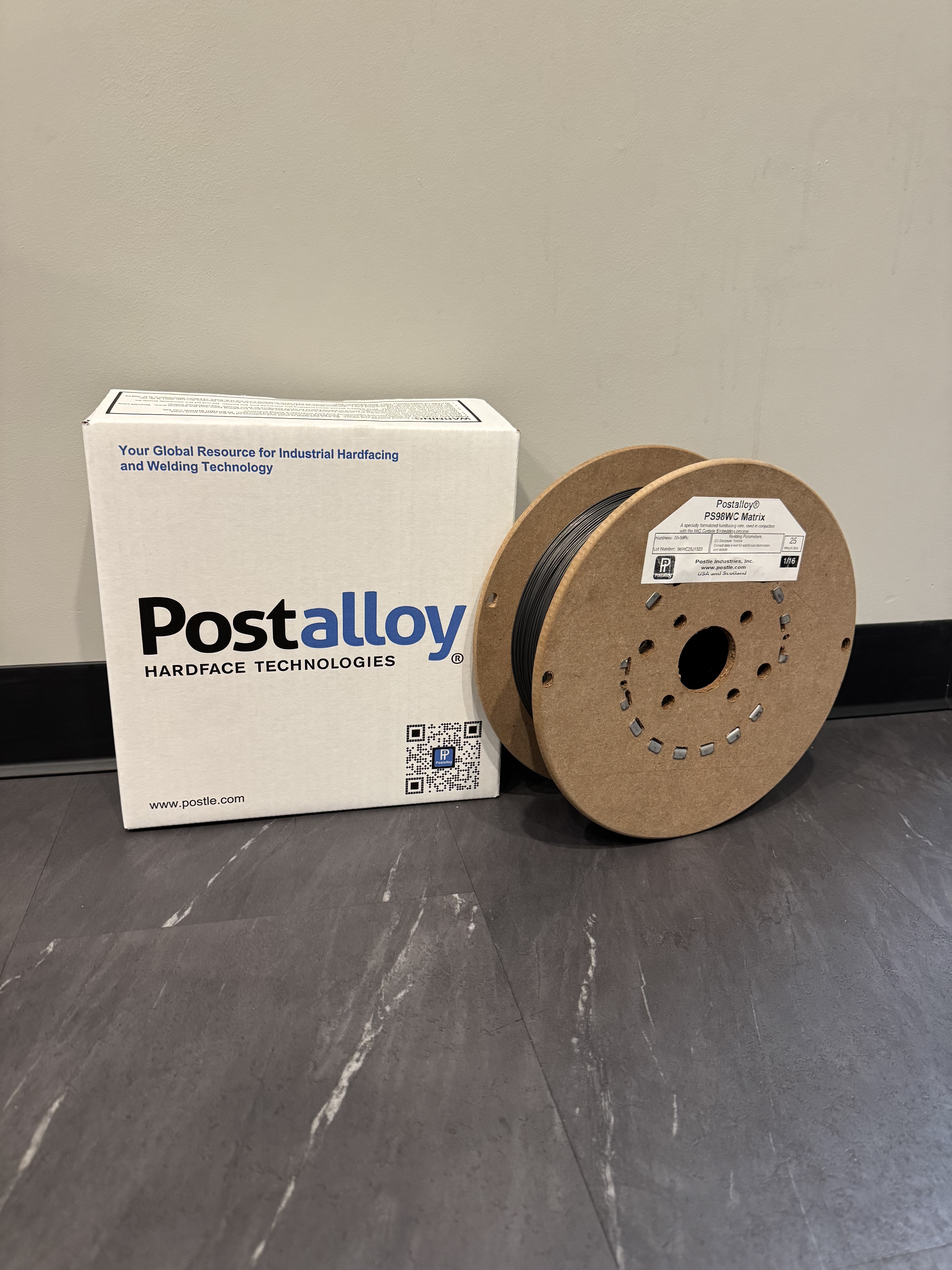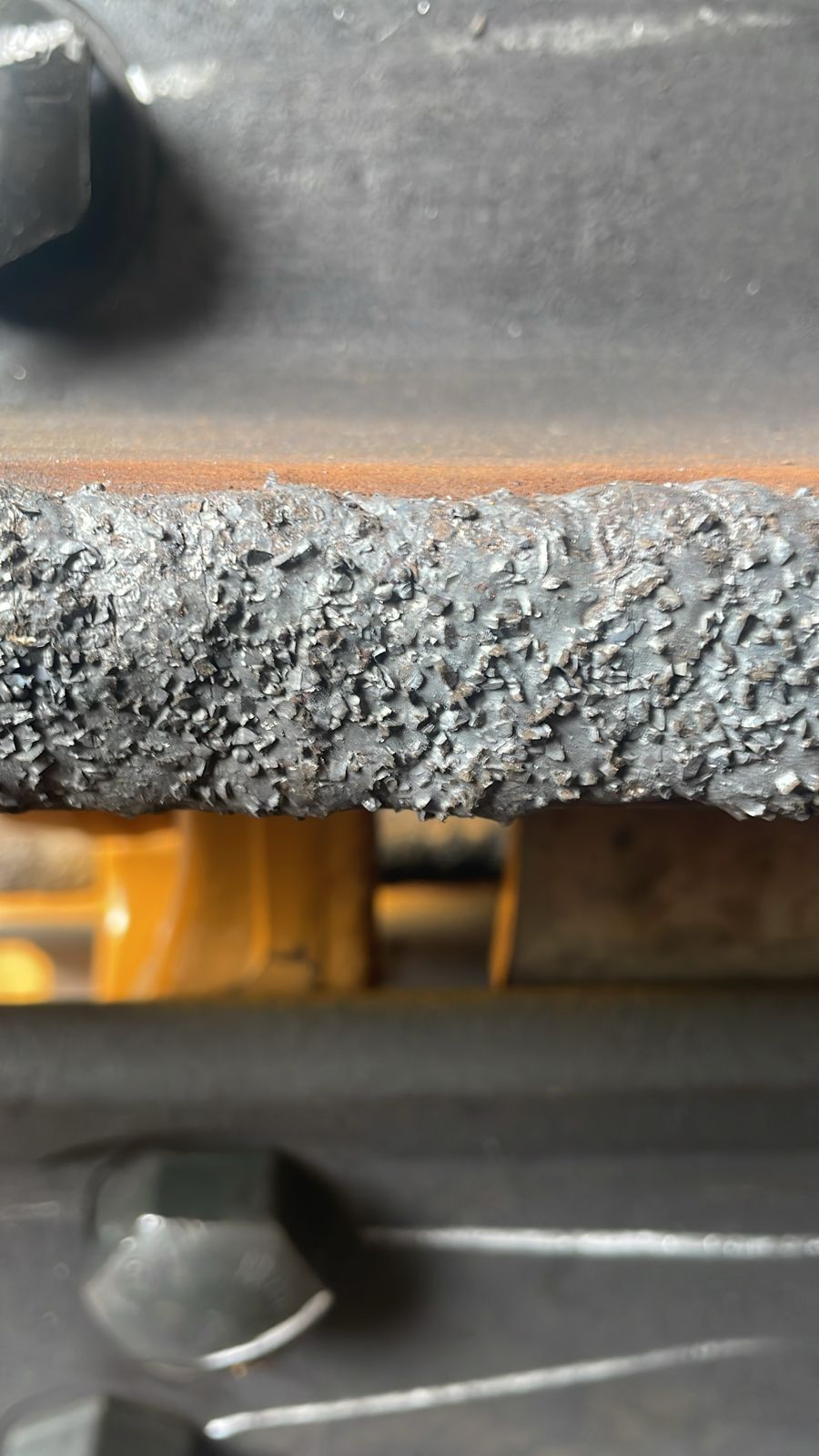




VIBRATORY FEEDER SYSTEM
Postalloy® DURAMAX vibratory feeder is an automated hardfacing system used to deliver tungsten carbide particles into a molten weld puddle through the (GMAW) Gas Metal Arc Welding process.
Included in this system:
• Vibratory Hopper / Feeder Assembly
• Multifunction Control Box
• Heat Resistant Feed Tube
• Dispensing Hose
• Torch Mount Bracket
• Dispensing Nozzle
• Current Sensing Reed Switch
• Foot Pedal (option available upon request)
• 110 Volt / 220 Volt (options available)
SYSTEM FUNCTIONS AND DESCRIPTION
Power is supplied to the system via 110 or 220 volts depending which option is
purchased. The Interconnecting cable connects the control box with the main hopper feeder. The POWER SWITCH powers the control box and vibratory motor on and off. The FLOW RATE DIAL controls the amount of carbide the feeder supplies. The higher the number, the higher the feed rate. A typical setting is somewhere between 3 and 5.
AUTOMATIC / MANUAL MODE:
The MAIN POWER toggle switch turns the Control Box on. The BYPASS switch changes the MODE between Manual (MAN.) and Automatic (AUTO). On MAN. the feeder will be activated, and the carbide will flow until the MAIN POWER toggle or BYPASS switch is turned off. Moving the BYPASS switch to the ON position activates the switch circuit which enables the use of a foot pedal or reed switch to turn the vibratory feeder on and off. A foot pedal and reed switch are included as part of the system package. The reed switch is a current sensing switch which can be attached to the welding ground lead, and automatically turns the feeder on and off when you start and stop welding. The reed switch must be mounted 90 degrees across either weld cable using electrical tape. DO NOT mount the reed switch parallel with the weld cable, current will not be detected.
FEED TUBE SETUP:
It is important that the Dispensing Hose remains relatively straight when welding. Once the tungsten carbide particles enter the Feed Tube, gravity causes the particles to drop down into the weld puddle. Any kinks or bends in the Dispensing Hose will cause an interruption to the carbide flow and may cause the hose to clog up.
ADDITIONAL INFORMATION WHEN WELDING WITH THE POSTALLOY® DURAMAX VIBRATORY SYSTEM:
SURFACE PREPARATION:
Always clean the welding surface with a grinding disc. A clean surface will reduce the potential of contamination from oils, grease, rust, dirt, paint etc. and will ensure a solid weld deposit is applied to the work piece.
WELDING/HARDFACING WIRE:
POSTALLOY® PS-98 MATRIX Hardfacing wire is widely used with the MIG CARBIDE EMBEDDING PROCESS. It is alloyed with chromium and molybdenum and was developed primarily to be used in conjunction with the MIG Carbide Embedding Process. POSTALLOY® PS-98 Matrix provides a clean molten and fluid weld deposit that readily accepts tungsten carbide grit of all sizes. To learn more about our POSTALLOY® PS-98 Matrix alloy contact your local technical sales representative.
The most versatile wire size is .045” (1.2mm) dia. wires that give the best results are metal-cored types, such as PS-98 Matrix or 2832-MCO (chromium carbide), and are typically used with higher than normal voltage settings to ensure the weld puddle stays fluid long enough to allow the carbide to enter and correctly disperse throughout the entire weld deposit. Voltage settings should be around 27 - 31 volts for a .045” (1.2mm) dia. wire.
WELDING TECHNIQUES:
Single layer welds are recommended, multi-layer welds have a tendency to melt the carbide in the lower layer which will dilute into the second weld deposit producing a very hard weld. When the deposit is too hard, it becomes prone to chipping or spalling when introduced to light impact. A weave or oscillation is recommended from ½” - 1” wide, and even wider should the application call for it. Oscillation should not exceed 1.5”, extreme oscillation could result in a reduced carbide deposition resulting in premature wear of the work piece. The aim point for the carbide is critical and should be directed into the last ½ of the molten weld puddle. Aiming too close to the arc will cause the carbides to melt causing a brittle weld deposit.
PRE-HEATING BASE METAL:
This is largely determined by the chemical composition and carbon content of the base
material. High carbon steels need preheat. The temperature that these materials will need to be pre-heated to is also dependent on the thickness of the steel. To learn more about pre-heat for different base metal alloys, contact your local POSTALLOY® technical sales representative.
SCREENING USED CARBIDE:
After several re-cycles, used carbide tends to pick up over-sized particles, spatter, dust, dirt, etc. This contamination will begin to affect the weldability. Approximately only half of the carbide dropped will enter the weld puddle, screen the re-cycled carbide through 8” diameter sieve screens of the same mesh size as the carbide being used. For example, if you are using 12 – 24 mesh carbide, use two screens and a bottom collection pan. The top set would be 12 mesh, the middle sieve will be 24 mesh. Reuse the carbide left on the 12-mesh screen and throw away everything left in the bottom collection pan. Although, the re-cycled carbide is much cleaner it is a safe practice to use a 50/50 mixture with new, unused carbide to prevent any potential issues with contamination.
CARBIDE MESH SIZING:
The most common carbide mesh sizes used:
FINE GRIT: 20 – 30 Mesh
MEDIUM GRIT: 14 – 24 Mesh
COARSE GRIT: 8 – 12 Mesh
Contact your local POSTALLOY® technical sales representative to discuss the correct carbide mesh size for your job.
CARBIDE DEPOSITION:
Deposition is subject to the type of wire and carbide mesh size being used. With .045” (1.2mm) wire, 120 - 160 gm/min of carbide would be a typical deposition rate. Too much carbide flow is detrimental and will cause the molten weld puddle to cool too quickly. When the weld puddle cools rapidly the matrix is unable to fully encapsulate the carbides leading to potential chipping and spalling of the weld deposit. On the opposite end, too little carbide in the weld deposit will cause premature wear results.
SHIELDING GASES and VOLTAGES:
All weld gases can be used with proper voltage modifications. Argon / Oxygen (2% or 5% oxygen) is the most popular mix used and tends to keep the weld puddle molten longer. Pure Argon can be used. However, it is colder and may cause issues with carbide deposition. 75% Argon 25% CO2 is also commonly used. Pure CO2 is the cheapest gas and can be used with higher voltages. Recommended weld settings listed below:
Wire Size .045” (1.22mm) 1/16"(1.6mm)
Volts 26 - 28 29 - 31
AMPS 170 - 220 180 - 300
Argon / O2 CFH: 35
Low Flat bead shape with medium penetration








